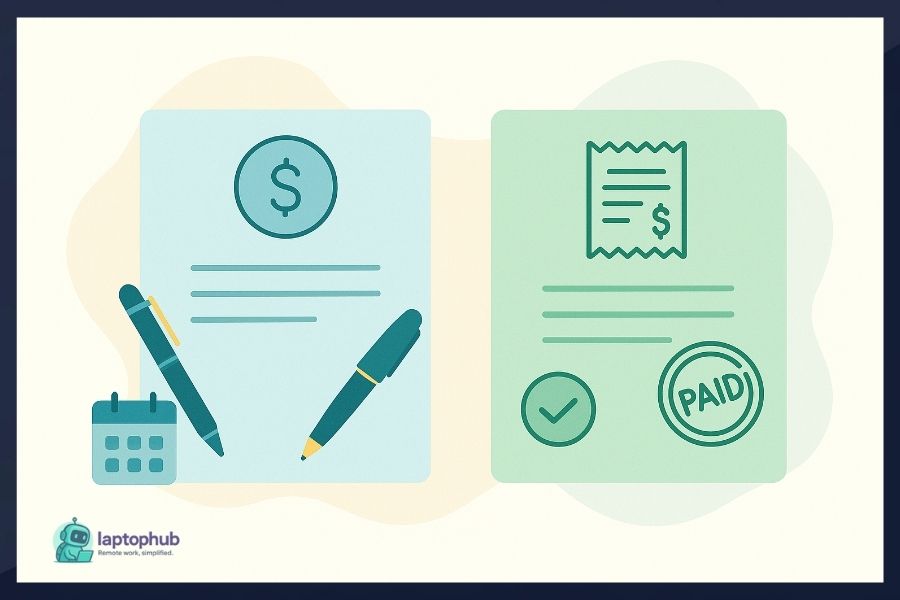Confusing a quote with an invoice might seem harmless—until you’re underpaid, overworked, or chasing down clients for money. The difference between quote and invoice is more than paperwork; it’s about setting expectations, protecting your time, and getting paid without hassle. Whether you’re freelancing, running a creative studio, or managing a small team, knowing how these two documents work can save you time, stress, and revenue.
💡Key takeaways:
- A quote outlines estimated costs and scope before a job starts, while an invoice requests payment after services are delivered.
- Using both quotes and invoices helps set clear expectations, ensures smoother client relationships, and protects your income.
- Quotes are non-binding until accepted, while invoices serve as legally binding payment requests essential for bookkeeping and taxes.
- Streamlining your workflow from quote to invoice helps maintain professionalism and improve cash flow in any service-based business.
What Is a Quote?
A quote is a document you send to a potential client before starting any work. It outlines the estimated cost based on the client’s requirements, timeline, and project scope. In essence, a quote is your offer to do the job at a certain price.
Common Features of a Quote:
- Sent before work begins
- Includes a cost estimate and timeline
- Lists services, pricing, and optional terms
- May include taxes, materials, and labor
- Usually has an expiration date
- Can be updated if the scope changes
- Often non-binding until accepted
Once a client accepts the quote—whether by email confirmation, signature, or digital approval—it becomes the baseline for your agreement.
Check out our free freelance quote generator template.
What Is an Invoice?
An invoice is a document sent after the work is done, or as work is completed in phases, requesting payment for services or products delivered. It’s a formal bill and often required for accounting, taxation, or legal records.
What an Invoice Typically Includes:
- Sent after work or milestones are completed
- Lists completed tasks or delivered items
- Includes a breakdown of charges
- Includes taxes, if applicable
- States payment terms (due date, methods, penalties)
- May include your bank details or payment link
- Includes an invoice number and date
Once you send an invoice, you’re asking to be paid—plain and simple.
Core Differences: Timing, Purpose, and Legal Standing
Let’s simplify it. A quote is a proposal; an invoice is a payment request.
| Feature | Quote | Invoice |
|---|---|---|
| Timing | Before any work begins | After work or at agreed milestones |
| Purpose | Offer of services and pricing | Request for payment |
| Binding? | Becomes binding when accepted | Legally binding payment request |
| Includes? | Estimate, scope, terms | Final costs, payment due, taxes |
| Expiration? | Yes, typically | No |
If you skip a quote, you might leave room for misunderstandings. If you skip an invoice, you’re risking your cash flow.
Why Quotes and Invoices Matter for Business Growth
Clear quotes and professional invoices help build trust. Clients like knowing what they’re getting, how much it’ll cost, and when they’re expected to pay. Here’s why these two documents matter more than you might think:
- Prevent Scope Creep: A clear quote outlines exactly what you’re doing—and not doing—so clients don’t expect extras for free.
- Project Transparency: Clients want transparency. Quotes help them understand pricing before they commit. Invoices back it up with a clear record.
- Build Professional Credibility: A freelancer or business that issues quotes and invoices consistently comes across as organized, experienced, and trustworthy.
- Enable Faster Payments: A good invoice is clear, accurate, and easy to pay. That means you spend less time chasing payments.
- Tax and Legal Compliance: Invoices are often required for income reporting and tax filing. If you’re ever audited, they serve as a paper trail.
Transitioning from Quote to Invoice: A Simple Workflow
One of the most overlooked parts of the quoting and invoicing process is how you move from one to the other. Here’s a quick workflow to make that transition seamless:
- Send the Quote: Include a detailed scope of work, estimated cost, terms, and expiration date.
- Get Approval in Writing: This could be a signed document, a digital signature, or an email confirmation.
- Start the Work: Stick closely to the agreed scope. If changes arise, update the quote and get reapproval.
- Track Your Work: Use time-tracking or project management tools to document your work accurately.
- Send the Invoice: When the job is done (or at a pre-defined milestone), issue an invoice based on the agreed quote.
- Follow Up: If payment isn’t received by the due date, send a polite reminder. Set automatic reminders if possible.
Keeping this process tight reduces friction and increases the chance you’ll get paid on time without disputes.
What to Include in Each Document
A Strong Quote Should Have:
- Your business details (name, email, phone number, address)
- Client’s contact information
- Quote number and date
- Project description and scope
- Itemized cost breakdown
- Estimated timeline or delivery date
- Quote expiration date (e.g., “valid for 14 days”)
- Payment terms or deposits required
- Terms & conditions (optional)
- Signature line (for approval)
A Professional Invoice Should Include:
- Your business and client information
- Invoice number and date
- Description of services/products delivered
- Quantity, unit rate, and total cost
- Tax, if applicable
- Payment terms (e.g., Net 15 or Net 30)
- Total amount due
- Accepted payment methods
- Optional: Late fees, notes, or thank-you message
Use consistent branding (like your logo and fonts) on both documents to maintain a professional appearance.
Legal and Tax Implications
Quotes:
While a quote is not automatically a contract, it becomes enforceable when accepted. You can strengthen this by attaching a service agreement or including terms within the quote itself.
Example: A client agrees to a $1,500 quote for photography. They later ask for more edits. If the extra work wasn’t part of the original quote, you’re within your rights to issue a new one or charge extra.
Invoices:
Invoices are considered legal documents. If a client refuses to pay, your invoice becomes part of the evidence in any legal action or debt recovery process. In some countries, issuing proper invoices is required by law for tax purposes. Always keep a digital or physical copy for your records.
Tools That Make the Process Easier
Don’t waste time building quotes and invoices from scratch. Use tools that streamline the process, keep records organized, and even automate follow-ups.
Popular Options:
- Bonsai – Designed for freelancers, includes quotes, contracts, time tracking, and invoicing.
- FreshBooks – Ideal for small service businesses, includes time tracking and easy-to-use templates.
- HoneyBook – Great for creatives, with built-in proposals and payment processing.
- QuickBooks – Best if you want full accounting features alongside invoicing.
- Zoho Invoice – Free and flexible for small businesses.
Most of these allow clients to approve quotes and pay invoices online, which speeds everything up. Or if you want something more simpler, check out our free freelance quote generator.
Quote vs Invoice examples
Web Developer:
- Quote: “Build 5-page responsive site for $2,500, includes one round of revisions.”
- Invoice: Sent after delivery, itemized to match quote. Total: $2,500.
Freelance Writer:
- Quote: “Write 4 blog posts at $200 each, delivered over 4 weeks.”
- Invoice: Sent weekly or monthly, listing completed posts.
Event Photographer:
- Quote: “4-hour shoot + 20 edited photos for $800.”
- Invoice: Delivered post-event, itemized, includes travel costs if applicable.
Quote vs invoice FAQS
Technically yes, but it’s risky. A quote protects you and sets client expectations. Without it, clients may question costs or dispute charges.
Only once accepted. It’s a proposal until the client agrees to it in writing.
Start with a friendly reminder 3–5 days after the due date. Then follow up weekly. Add late fees if you’ve included them in your terms.
In some industries, they’re used interchangeably. But generally, a quote is more formal and binding, while an estimate is rough and subject to change.
If you’ve issued a clear and accurate invoice, it can be used as legal evidence to pursue payment or debt recovery.
Final thoughts
Understanding the difference between quote and invoice gives you more than just control over your billing—it gives you leverage. It shows clients you run a serious operation, it protects your work from misunderstandings, and it keeps your payments organized and predictable. Don’t leave room for confusion. Use quotes to set the terms, and invoices to seal the deal. That’s how you run a professional business that clients respect—and pay on time.


